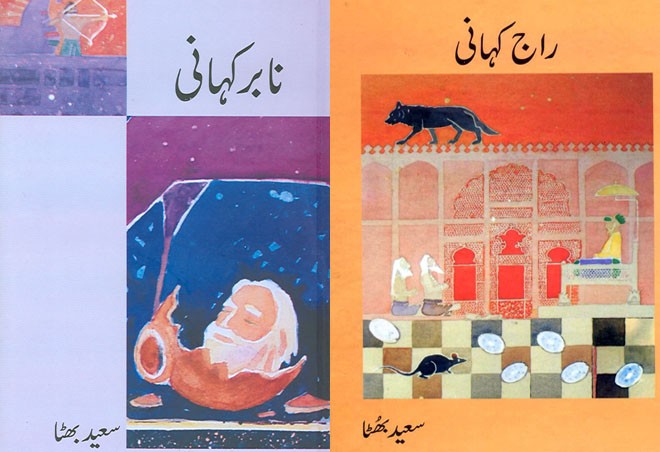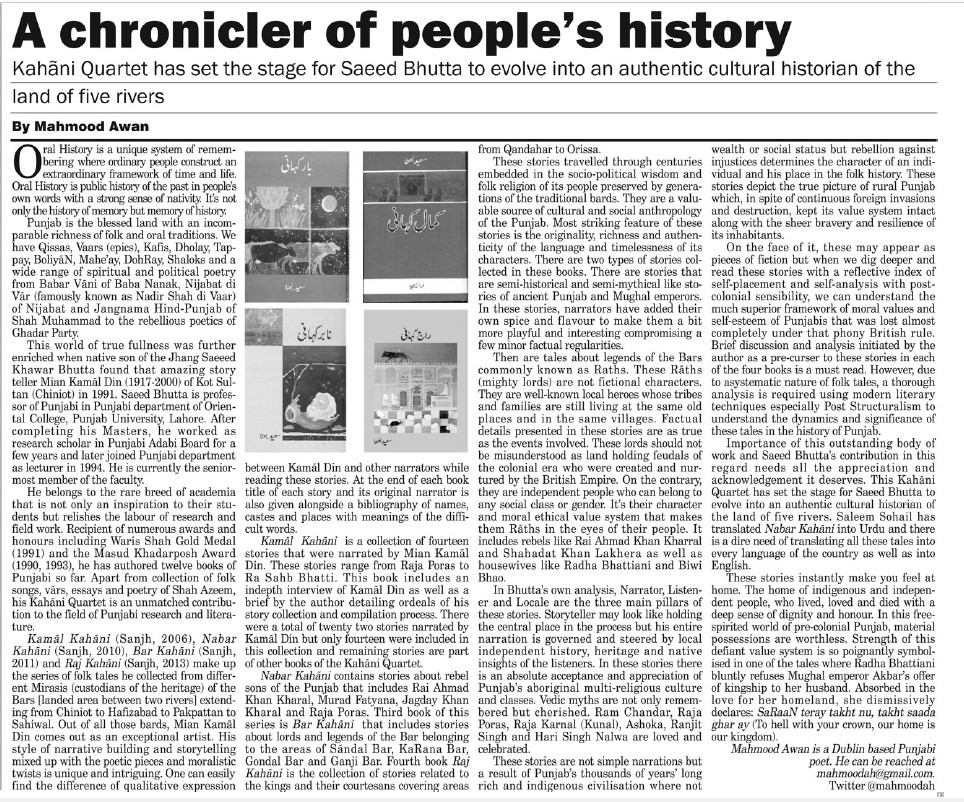Mahmood Awan (The News on Sunday, 14th June 2015)
Oral History is a unique system of remembering where ordinary people construct an extraordinary framework of time and life. Oral History is public history of the past in people’s own words with a strong sense of nativity. It’s not only the history of memory but memory of history.
Punjab is the blessed land with an incomparable richness of folk and oral traditions. We have Qissas, Vaars (epics), Kafis, Dholay, Tappay, BoliyãN, Mahe’ay, DohRay, Shaloks and a wide range of spiritual and political poetry from Babar Vãni of Baba Nanak, Nijabat di Vãr (famously known as Nadir Shah di Vaar) of Nijabat and Jangnama Hind-Punjab of Shah Muhammad to the rebellious poetics of Ghadar Party.
This world of true fullness was further enriched when native son of the Jhang Saeeed Khawar Bhutta found that amazing story teller Mian Kamãl Din (1917-2000) of Kot Sultan (Chiniot) in 1991. Saeed Bhutta is professor of Punjabi in Punjabi department of Oriental College, Punjab University, Lahore. After completing his Masters, he worked as research scholar in Punjabi Adabi Board for a few years and later joined Punjabi department as lecturer in 1994. He is currently the senior-most member of the faculty.
He belongs to the rare breed of academia that is not only an inspiration to their students but relishes the labour of research and field work. Recipient of numerous awards and honours including Waris Shah Gold Medal (1991) and the Masud Khadarposh Award (1990, 1993), he has authored twelve books of Punjabi so far. Apart from collection of folk songs, vãrs, essays and poetry of Shah Azeem, his Kahãni Quartet is an unmatched contribution to the field of Punjabi research and literature.
Kamãl Kahãni (Sanjh, 2006), Nabar Kahãni (Sanjh, 2010), Bar Kahãni (Sanjh, 2011) and Raj Kahãni (Sanjh, 2013) make up the series of folk tales he collected from different Mirasis (custodians of the heritage) of the Bars [landed area between two rivers] extending from Chiniot to Hafizabad to Pakpattan to Sahiwal. Out of all those bards, Mian Kamãl Din comes out as an exceptional artist. His style of narrative building and storytelling mixed up with the poetic pieces and moralistic twists is unique and intriguing. One can easily find the difference of qualitative expression between Kamãl Din and other narrators while reading these stories. At the end of each book title of each story and its original narrator is also given alongside a bibliography of names, castes and places with meanings of the difficult words.
Kamãl Kahãni is a collection of fourteen stories that were narrated by Mian Kamãl Din. These stories range from Raja Poras to Ra Sahb Bhatti. This book includes an indepth interview of Kamãl Din as well as a brief by the author detailing ordeals of his story collection and compilation process. There were a total of twenty two stories narrated by Kamãl Din but only fourteen were included in this collection and remaining stories are part of other books of the Kahãni Quartet.
Nabar Kahãni contains stories about rebel sons of the Punjab that includes Rai Ahmad Khan Kharal, Murad Fatyana, Jagday Khan Kharal and Raja Poras. Third book of this series is Bar Kahãni that includes stories about lords and legends of the Bar belonging to the areas of Sãndal Bar, KaRana Bar, Gondal Bar and Ganji Bar. Fourth book Raj Kahãni is the collection of stories related to the kings and their courtesans covering areas from Qandahar to Orissa.
These stories travelled through centuries embedded in the socio-political wisdom and folk religion of its people preserved by generations of the traditional bards. They are a valuable source of cultural and social anthropology of the Punjab. Most striking feature of these stories is the originality, richness and authenticity of the language and timelessness of its characters. There are two types of stories collected in these books. There are stories that are semi-historical and semi-mythical like stories of ancient Punjab and Mughal emperors. In these stories, narrators have added their own spice and flavour to make them a bit more playful and interesting compromising a few minor factual regularities.
Then are tales about legends of the Bars commonly known as Raths. These Rãths (mighty lords) are not fictional characters. They are well-known local heroes whose tribes and families are still living at the same old places and in the same villages. Factual details presented in these stories are as true as the events involved. These lords should not be misunderstood as land holding feudals of the colonial era who were created and nurtured by the British Empire. On the contrary, they are independent people who can belong to any social class or gender. It’s their character and moral ethical value system that makes them Rãths in the eyes of their people. It includes rebels like Rai Ahmad Khan Kharral and Shahadat Khan Lakhera as well as housewives like Radha Bhattiani and Biwi Bhao.
In Bhutta’s own analysis, Narrator, Listener and Locale are the three main pillars of these stories. Storyteller may look like holding the central place in the process but his entire narration is governed and steered by local independent history, heritage and native insights of the listeners. In these stories there is an absolute acceptance and appreciation of Punjab’s aboriginal multi-religious culture and classes. Vedic myths are not only remembered but cherished. Ram Chandar, Raja Poras, Raja Karnal (Kunal), Ashoka, Ranjit Singh and Hari Singh Nalwa are loved and celebrated.
These stories are not simple narrations but a result of Punjab’s thousands of years’ long rich and indigenous civilisation where not wealth or social status but rebellion against injustices determines the character of an individual and his place in the folk history. These stories depict the true picture of rural Punjab which, in spite of continuous foreign invasions and destruction, kept its value system intact along with the sheer bravery and resilience of its inhabitants.
On the face of it, these may appear as pieces of fiction but when we dig deeper and read these stories with a reflective index of self-placement and self-analysis with post-colonial sensibility, we can understand the much superior framework of moral values and self-esteem of Punjabis that was lost almost completely under that phony British rule. Brief discussion and analysis initiated by the author as a pre-curser to these stories in each of the four books is a must read. However, due to asystematic nature of folk tales, a thorough analysis is required using modern literary techniques especially Post Structuralism to understand the dynamics and significance of these tales in the history of Punjab.
Importance of this outstanding body of work and Saeed Bhutta’s contribution in this regard needs all the appreciation and acknowledgement it deserves. This Kahãni Quartet has set the stage for Saeed Bhutta to evolve into an authentic cultural historian of the land of five rivers. Saleem Sohail has translated Nabar Kahãni into Urdu and there is a dire need of translating all these tales into every language of the country as well as into English.
These stories instantly make you feel at home. The home of indigenous and independent people, who lived, loved and died with a deep sense of dignity and honour. In this free-spirited world of pre-colonial Punjab, material possessions are worthless. Strength of this defiant value system is so poignantly symbolised in one of the tales where Radha Bhattiani bluntly refuses Mughal emperor Akbar’s offer of kingship to her husband. Absorbed in the love for her homeland, she dismissively declares: SaRaaN teray takht nu, takht saada ghar ay (To hell with your crown, our home is our kingdom).
Published on 14th June 2015 in The News on Sunday.
https://www.thenews.com.pk/tns/detail/558819-saeed-bhutta-chronicler-of-peoples-history


